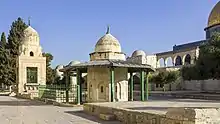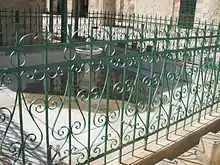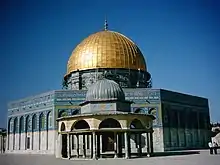Fountain of Qasim Pasha
The Fountain of Qasim Pasha (Arabic: سبيل قاسم باشا) also known as the Fountain of the Bitter Orange (Sabil an-Nāranj) is an ablution and drinking fountain (sebil or sabil) in the western esplanade of the al-Aqsa Compound in the Old City of Jerusalem.[1] It is located on the western site of al-Aqsa Mosque.[1] It is situated in front of the Chain Gate.[2]

History
The fountain was built by Qasim Pasha, the Ottoman governor of Jerusalem in 1527 during the reign of Suleiman the Magnificent, making it the first public structure to be built on the Haram al-Sharif (al-Aqsa Compound) by the Ottomans. Earlier Ottoman works on the site were not the construction of newer buildings but the restoration of the walls.[3] The sebil (fountain) originally got its water supply from a water channel, but today it is supplied with water from al-Aqsa's water system.[4]
A wooden colonnade was added to protect the benches and steps surrounding the Fountain of Qasim Pasha from rain and the summer-time sun in the 1920s restoration by the Supreme Muslim Council. Its dome was rebuilt during the restoration, and covered with lead panels that gave it a pointed and shallower profile. In 1998, the lead sheeting was replaced by a finely crafted stone.[3]
Sabil Qasim Pasha (‘Qasim Pasha Fountain’), also known as Sabil Bab al-Mahkama (‘Fountain of the Palace House’) and Sabil an-Naranj (or spelled al-Naranj, ‘Fountain of the bitter orange’), is the first Ottoman public building to be built in Jerusalem. The earlier works were not new buildings, but the restoration of the wall and the conversion of the Jerusalem fortress into the Masjid al-Nabi Dawud (Mosque of the Prophet David). The function of this sabil – like other sabils – was to supply fresh water to the public for drinking and ablutions. There are accounts that the sabil was in use until the late 1940s.
Architecture
It is an octagonal building consisting of 1.43 metres long sides, topped by a dome.[1] The structure is preceded by a square shallow pool, with marble paving and a modern fountain in its centre. [5] Around the Sabil, there is a wooden canopy covered with lead which protects worshipers from the sun and rain.[1] It is mounted by green pillars and descending into it by four steps to perform ablution and drinking.[1] It has 16 faucets and several stone benches.[1] Sabil Qasim Pasha is the oldest building built in the Ottoman era in al-Aqsa mosque. The dome of the structure is built atop an octagonal drum.[2]
Sabil Qasim Pasha is unique in its design and differs from other Jerusalem and al-Aqsa Mosque sabils. The Aqsa Mosque is the first monument built during the Ottoman period. Therefore, prior to the famous projects of Sultan Suleiman I, they included the restoration project of the al-Aqsa Mosque, the sabils (drinking water fountains), the wing (canal) of Sabil and The Jerusalem Wall. The Sebil originally received its water from a water channel or aqueduct, but today water is supplied through the al-Aqsa Mosque water system.

Sabil Qasim Pasha is north of Sabil Qaitbay, another fountain, which sits on a mastaba (elevated platform) called the Mestaba Sabil Qaitbay, founded by Ashraf Abu al-Nassar in 860 CE. The mastaba also has a mihrab.[6][7][8] In between the two fountains, there is a fenced-off shallow pool called the Pond of the Bitter Orange (بركة النارنج Birka an-Nāranj).
Inscription
There is an Arabic inscription on the monument, which means:
"This blessed sabil has been constructed for the benefit and countenance of Extolled Allah, in the days of our master, the greatest sultan, the second Süleyman, the ruler of the World, son of Sultan Selim Khan, sultan of Arab and Persian (non-Arab) lands; by our master, Kasim Pasha, may Allah facilitate what he has intended; by the hands of the slave who is in need of Allah, Abdarrabbihi Mustafa, in the year of 933 at the end of month Shaʿban."[9]
The inscription is dated Shaʿban 933 (1527).[9] It is the earliest inscription where Sultan Süleyman is described with the most interesting honorific title as Süleyman el-sanî (‘the Second Salomon’).[9]
Kasim Pasha, who has ordered the construction of this sabil, is Güzelce Kasim Pasha (Güzelce Kasım Paşa), grand vizier of Süleyman.[9] Kasim Pasha was appointed in the year of 930 as governor (wali) of Egypt, and was closely connect to the holy city as a governor.[9] Kasim Pasha was commander of naval forces (the kaptan-ı derya) in the Ottoman Empire.[9]
References
- "Sabil Qasim Pasha". Madain Project. Retrieved 21 May 2021.
{{cite web}}: CS1 maint: url-status (link) - Qasim Pasha Sabil Archived 2011-05-25 at the Wayback Machine Archnet Digital Library.
- Al-Aqsa Guide Friend of al-Aqsa 2007. Archived October 6, 2008, at the Wayback Machine
- "Sabil Qasim Pasha". Madain Project. Retrieved 26 May 2019.
- "Sabil Qasim Pasha". Archnet.
{{cite web}}: CS1 maint: url-status (link) - https://www.davamizkudus.org/kudus-video/kasimpasa-sebili-kudusun-taslari/.
{{cite web}}: Missing or empty|title=(help) - "Mescidi Aksa Rehberi" (PDF).
- https://madainproject.com/fountain_of_qasim_pasha.
{{cite web}}: Missing or empty|title=(help) - Tütüncü, Mehmet (2003). Turkish Jerusalem (1516-1917): Ottoman Inscriptions from Jerusalem and Other Palestinian Cities. Haarlem, Netherlands: SOTA / Turkestan and Azerbaijan Research Center. pp. 34–35. ISBN 90-807403-4-9.
